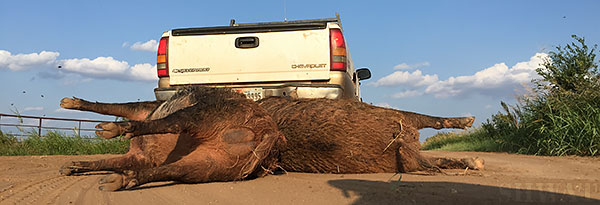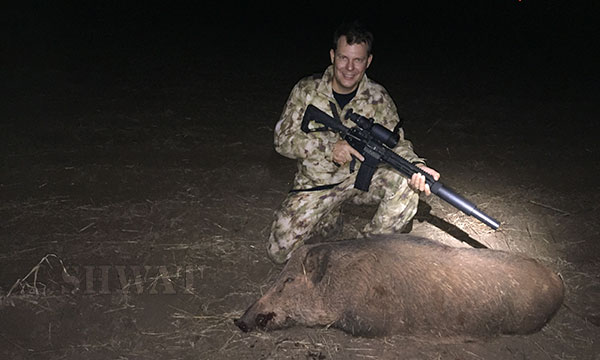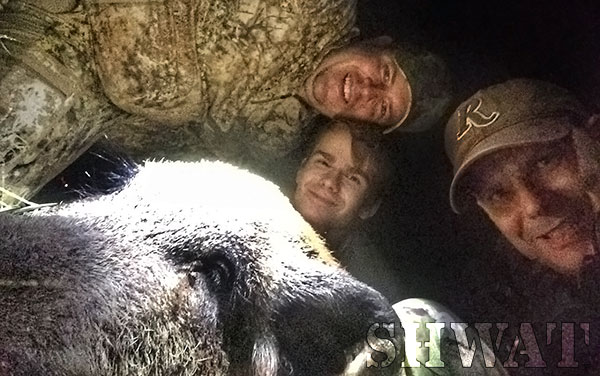
This simple post to LinkedIn revealed again that when it comes to dealing with wild hogs, we’re not educating people well: “Never bought gear to hunt at night? Rent it! Here’s the @trijicon @irdefense Hunter MK2 from @ultimatenightvision and the results. Paired to @tacticalsol 300Blk AR15 running @silencerco Harvester Subsonics, we dropped some poundage in pigs!”
First comment popped up quickly from a gentleman named Barry: “Was all the meat used to feed someone or were they just piled up please reply it will take a load off of your post I promise!!”
I started answering Barry, but I ran out of room. So if you’re reading this Barry, this is for you…
Thanks for asking, Barry. It gives me another opportunity to revisit the often restated realities of those living with wild hog issues. First, let’s consider your question: “Was all the meat used to feed someone or were they just piled up[?]”

The binary question offers only two possible answers, disallowing the infinite number of other real options that exist within the context on the ground, but which do not exist in the hypothetical world in which the question was posed. As is often the case with binary questioning, this hypothetical has little resemblance to reality. I imagine that what you’re most interested in, besides graciously giving me the chance to “take a load off” by answering here, is the actual reality as it exists on the ground for the hunting scenario referred to in my post. So let’s get to it…
This particular wild hog, along with 200 or so more in at least four large groups plus a number of boars out on their own, was working over a very large plowed wheat field of a recently widowed great-grandmother living in the center of that field. We’ll call her “Momma Sue” to respect her privacy. The field was to be planted with fresh seed in three days time. The harvest that will eventually come pays the little lady’s bills.
As I’m sure you know, hogs destroy crops. They do literally billions of dollars in damage each year resulting in legislation banning them from being brought into some states while states like Texas – where that great-grandmother lives – are no-holds-barred-kill-them-all-with-whatever-you-can-bring-to-the-table kinds of places.
That makes for great academic studies at places like Texas A&M University, but it’s a real practical impact on folks like Momma Sue. You probably also know hogs can be mean. One of my neighbors in Texas was an Emergency Room Surgeon who had plenty of stories to tell about guys who ended up on the receiving end of wild hog wrath. I’m sure you’d agree that we don’t want Momma to end up in the same boat.
These are not bacon bearing piggies, nor do they yield honey glazed hams. They are nasty, often diseased feral swine and will sometimes even cannibalize each other. Does that sound like a gift you’d like to share, much less consume yourself?
Granted, a nice small six-month-old might prove tasty, but the wild hog diet in West Texas isn’t generally conducive to culinary excellence. Quite the contrary, actually. Maybe somewhere, but not where this hunt occurred.
Now, let’s find a shelter or a humanitarian organization nearby that would take the meat, such as it is. You’d have to drive a distance equal to crossing several east coast state lines to find such an entity. And they’d have to actually WANT it. And you might want to tell them that the hogs they are receiving sat in 95-105 degree heat for a few hours before you could get them collected, drive 45 minutes back to HQ to dress them out and butcher them.
To quell storms of indignation, some call the afore mentioned activity “hog eradication” rather than “hog hunting.” The later, after all, conjures images of tweed clad pipe puffing fine gentlemen with museum grade rifles respectfully “harvesting” noble beasts with “ethical” shots in the golden light of the breaking dawn. Sorry, that’s just not the case here.
Eradication by a couple of guys with thermal optics on suppressed AR15s simply isn’t going to happen. But we can put some pressure on the wild hog population. Maybe they’ll find someplace other than Momma Sue’s patch of Texas.
So what happens to wild hogs when they die? It depends a lot on where they die. In the middle of Nowhereville West Texas it’s predictable when those like us serving the greater good show up. Sometimes the hogs wind up as a fresh meal for the coyotes. And yes, we’ve even piled up a few to clear a field for planting. If we’re not in too big of a hurry, we take pictures of them.
Hope that clears things up, Barry. Thanks again for asking.

Want More on Hog Hunting? Go >>>


